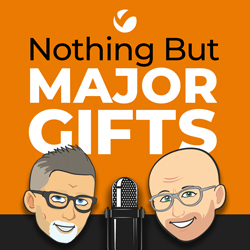I love learning and talking about the art of fundraising. I find the complexity of being human, personal growth, and building authentic relationships fascinating.
But the thing is, no matter how good you are at the art of fundraising, you won’t be successful if you don’t also apply the science of fundraising.
I know because I learned this lesson firsthand; I used to be that struggling scientist. As a major gift officer at a major university, I didn’t have a structure to help me make sure I took good care of the donors on my caseload as individuals. It felt like I was trying to keep hundreds of balls rolling up a hill, and they were always rolling past me.
Without a clear plan and goal for each donor around their passions and interests, it was a hit-or-miss process. Sometimes the follow-up that I intended to do fell through the cracks, forgotten when a new fire hit my desk. Or, I realized it was time to ask for a gift, and I had not planned ahead to do the proper cultivation and exploration of interest.
It was hard to practice creativity and send meaningful touch points because I didn’t know where I was going and couldn’t work ahead. It was embarrassing, and I felt badly about the job I was doing.
My actions didn’t match my heart, and as a result, more often than I cared to admit, I was treating my donors as sources of cash instead of partners.
When I joined Veritus, I was so excited about the balance of our data-driven, structured, and systematic approach to our consulting and training services for relational fundraising. It really is the science of fundraising. And it’s not just something we theorize and talk about. We implement it alongside hundreds of fundraisers every day, and we see over and over again how this not only raises significantly more revenue, but celebrates the key role of donors as partners in the mission. And it makes the very challenging job of being a Major Gift Officer a lot more fun!
We call this system and structure The Veritus Way, and if you’re not familiar with what that entails, here is a quick rundown of the steps to implement this structure for a major gift program.
Step 1: Analyze Organizational Data
Gather intelligence on donor behavior, value attrition rates, trends, and areas of opportunity to understand where your fundraising program stands now and project your 5-year potential.
Step 2: Qualify Donors
Our 7-step qualifying process ensures that you only add donors to your caseload who want to relate to you and your organization. A full-time major gift officer can manage a fully qualified caseload of 150 people.
Step 3: Identify Donors’ Passions and Interests
Discover what it is about your organization that truly speaks to each donor’s heart, and determine their communication preferences. This allows you to then connect their interests to the work you do.
Step 4: Tier Donors
You can’t spend equal time with 150 donors, so tier them A-C to help focus your planning and time effectively.
Step 5: Determine Each MGO’s Revenue Goal
Review the donor’s contribution history over the last four years, add in what you know about them, determine their capacity, and project a 12-month goal for each individual donor.
Step 6: Build a Plan For Each Donor
Create a strategy to serve each donor’s passions and interests with a 12-month touch point plan. We manage this structure using the Donor Engagement Plan (DEP) which allows you to plan ahead and be nimble as things change and you learn more.
Step 7: Create Donor Offers
Create program offers you can share with donors that include the meaningful story and impact along with the total cost (including overhead) for each program.
Step 8: Create Accountability
Meet with your manager regularly to review your individual donor plans, make adjustments, develop strategy, and track progress toward individual goals and overall giving.
As you can imagine, having this system and structure in place is a game changer. This is the power of the science of fundraising.
Because each donor is qualified, you’re no longer chasing donors who never respond, which gives you more time to focus on those who will. You are in two-way conversation with every donor on your caseload, so you can actually utilize the art of fundraising effectively to build real partnerships.
You know your plan for each donor and can easily pivot and be creative as you learn more about their needs and interests. With a plan, you don’t forget to follow up and tell them they are making a difference, or thank them properly, or cultivate them with new information before you ask for a gift.
This moves the relationship from transactional to relational where your talents for the art of fundraising can thrive.
And you like yourself and your job more too! Why? You don’t find yourself as scattered, overwhelmed, and feeling guilty for not following up with donors properly. You come into work with clear priorities, and you know what needs to be done each day to fulfill your individual donor plans.
When you feel good about yourself, and the job you’re doing, you’re also more connected with your intuition. When you have a plan rooted in the science of fundraising, you can relate more from your whole, authentic self, bringing all of your intuitive fundraising skills to the table.
Isn’t that a powerful place to be?
Karen







0 Comments